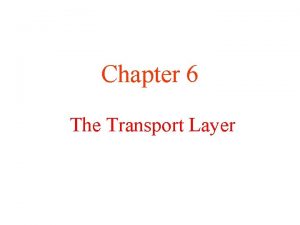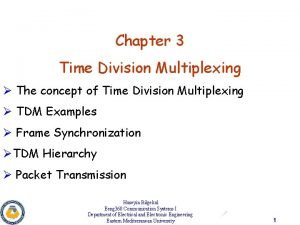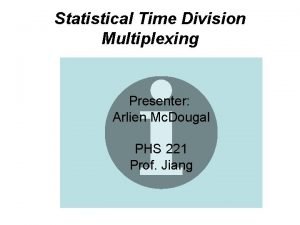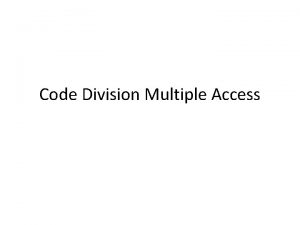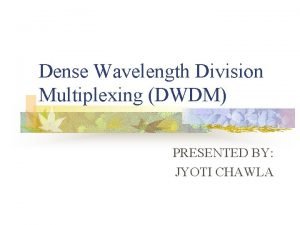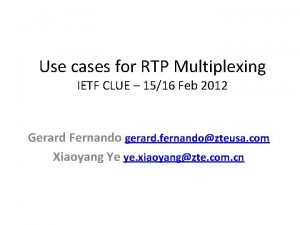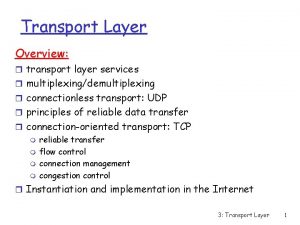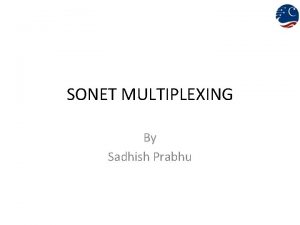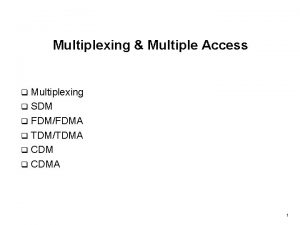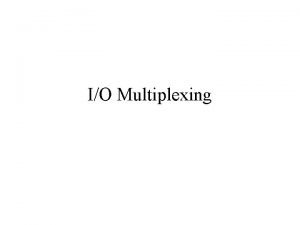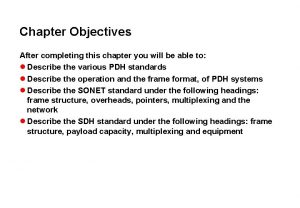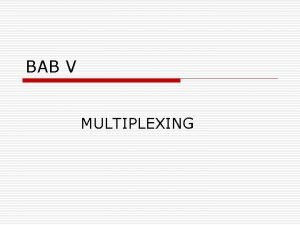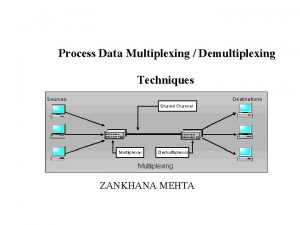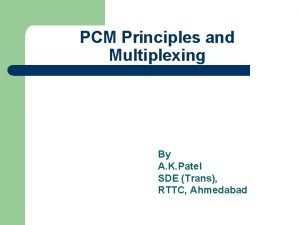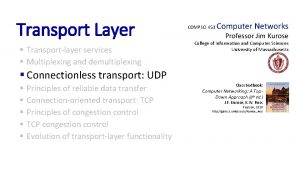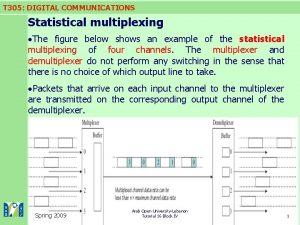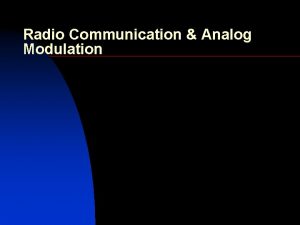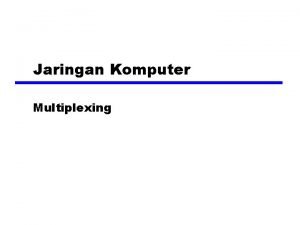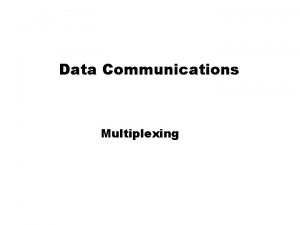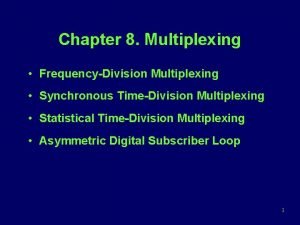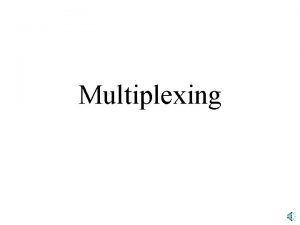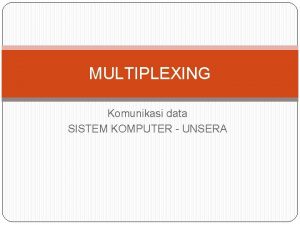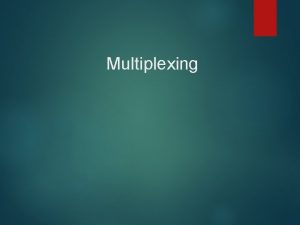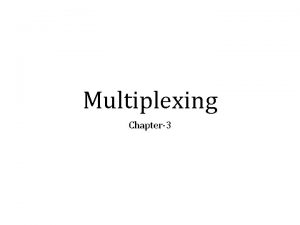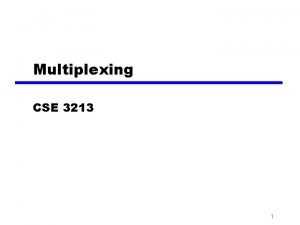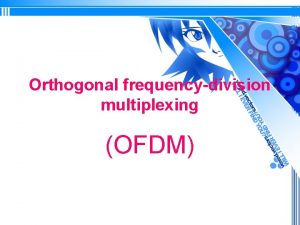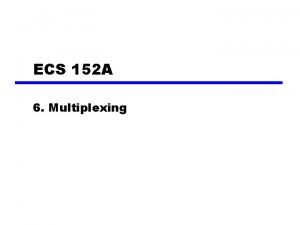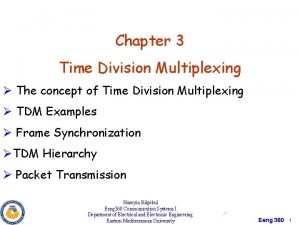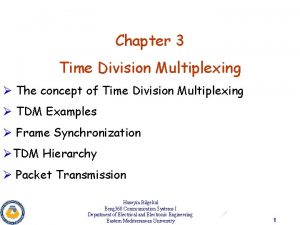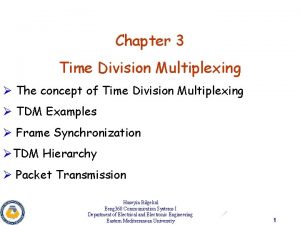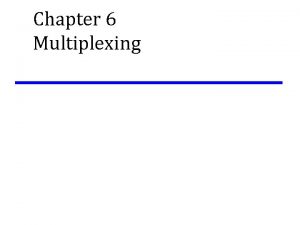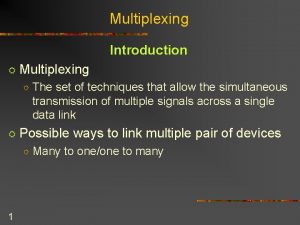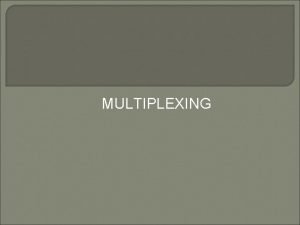Chapter 3 Time Division Multiplexing The concept of























- Slides: 23

Chapter 3 Time Division Multiplexing Ø The concept of Time Division Multiplexing Ø TDM Examples Ø Frame Synchronization ØTDM Hierarchy Ø Packet Transmission Huseyin Bilgekul Eeng 360 Communication Systems I Department of Electrical and Electronic Engineering Eastern Mediterranean University 1

Frequency Division Multiplex Separation of spectrum into smaller frequency bands Ø Channel gets band of the spectrum for the whole time Channels Ø Advantages: Ø l l Ø no dynamic coordination needed works also for analog signals l l k 3 k 4 k 5 k 6 c Disadvantages: l ki f waste of bandwidth if traffic distributed unevenly inflexible guard spaces t 2

Time Division Multiplex Ø Channel gets the whole spectrum for a certain amount of time Ø Advantages: l l Ø only one carrier in the medium at any time throughput high even for many users Channels ki c k 1 k 2 k 3 k 4 k 5 k 6 f Disadvantages: l precise synchronization t necessary 3

Time and Frequency Division Multiplex A channel gets a certain frequency band for a certain amount of time (e. g. GSM) Ø Advantages: Channels k Ø l l l Ø better protection against tapping protection against frequency c selective interference higher data rates compared to code multiplex i k 1 k 2 k 3 k 4 k 5 k 6 f Precise coordination required t 4

Code Division Multiplex k 1 k 2 k 3 Channels ki k 4 Each channel has unique code Ø All channels use same spectrum at same time Ø Advantages: Ø l l l Ø k 6 c bandwidth efficient no coordination and synchronization good protection against interference f Disadvantages: l l Ø k 5 lower user data rates more complex signal regeneration t Implemented using spread spectrum technology 5

Multiplexing Ø Two basic forms of multiplexing. (a) Frequency-division multiplexing (FDM) (with guardbands). (b) Time-division multiplexing (TDM); no provision is made here for synchronizing pulses. FDM TDM 6

TDM Ø Composition of one frame of a multiplexed PAM signal incorporating four voicesignals and a synchronizing pulse. 7

Frequency Division Multiplexing (FDM) Ø Block diagram of FDM system, showing the important constituents of the transmitter and receiver. 8

Time Division Multiplexing Definition: Time Division Multiplexing (TDM) is the time interleaving of samples from several sources so that the information from these sources can be transmitted serially over a single communication channel. At the Transmitter ØSimultaneous transmission of several signals on a time-sharing basis. Ø Each signal occupies its own distinct time slot, using all frequencies, for the duration of the transmission. Ø Slots may be permanently assigned on demand. At the Receiver Ø Decommutator (sampler) has to be synchronized with the incoming waveform Frame Synchronization Ø Low pass filter Ø ISI – poor channel filtering Ø Feedthrough of one channel's signal into another channel -- Crosstalk Applications of TDM: Digital Telephony, Data communications, Satellite Access, Cellular radio. 9

Time Division Multiplexing Conceptual diagram of multiplexing-demultiplexing. PAM TDM System 10

Illustrating 4 -Channel PAM TDM Multiplexing 11

Digital Time Division Multiplexing Ø Time Division Multiplexing (TDM) can be accomplished at bit or byte (word) level. Ø Channhels having different data rates can also be TDM multiplexed but must be interleaved accordingly. Digit Interleaving WORD or Byte Interleaving channel with different bit rates using two 12 multiplexers

Block diagram of TDM system. PAM TDM System A Typical Framing Structure for TDM 13

Time Division Multiplexing Frame structure of a certain TDM signal Composite Signal Format 14

Time Division Multiplexing Pulse width of TDM PAM: Pulse width of TDM PCM: 15

Pulse Stuffing in TDM Ø Stuff bits, which are dummy bits are inserted in the TDM output data when the different inputs are not completeley synchronized or the different input rates are not related by a ratinal number. 16

Pulse Stuffing in TDM Ø Stuff bits, which are dummy bits are inserted in the TDM output data when the different inputs are not completeley synchronized or the different input rates are not related by a ratinal number. Multiplexing of two data streams with bit stuffing 17

TDM Example (Multiplexing Analog and Digital) ØSource 1: 2 k. Hz bandwidth. ØSource 2: 4 k. Hz bandwidth. 16 ksam/s Ø Source 3: 2 k. Hz bandwidth. Ø Source 4 -11: Digital 7200 bits/sec. 8 x 7. 2=57. 6 kb/s Use stuff bits to complete 7. 2 to 8 kb/s. Now 8 and 64 rates are complete multıples 64 kb/s 128 kb/s 18

Frame Synchronization Ø To sort and direct the received multiplexed data to the appropriate output channel Ø Two ways to provide frame sync to the demultiplexer circuit - Over a separate channel - Deriving from the TDM signal itself Ø Frame sync (unique k-bits) +Information words of an N-channel TDM system 19

TDM PAM for Radio Telemetry 20

CCITT Digital TDM Hierarchy 21

Packet Transmission System Ø TDM is Synchronous Transfer Mode (STM) technology - Data source is assigned a specific time slot – fixed data rate - More efficient when sources have a fixed data rate - Inefficient to accommodate bursty data source Solution? Ø Packet Transmission System - Partitions source data into data packets (destination address, header) - Efficiently assigns network resources when the sources have bursty data - Examples : Internet TCP/IP technology and the Asynchronous Transfer Mode (ATM) technology. 22

Summary Ø How information in analog waveforms can be represented by digital signaling Ø How to compute the spectra for line codes Ø How filtering of the digital signal, due to the communication channel affects our ability to recover the digital information at the receiver [ISI] Ø How we can merge information from several sources into one digital signal by using time division multiplexing (TDM) 23
 Upward multiplexing and downward multiplexing
Upward multiplexing and downward multiplexing Crash recovery in transport layer geeksforgeeks
Crash recovery in transport layer geeksforgeeks Block diagram of time division multiplexing
Block diagram of time division multiplexing Statistical time division multiplexing
Statistical time division multiplexing Code division multiplexing
Code division multiplexing Long term evolution - advanced
Long term evolution - advanced Dwdm presentation
Dwdm presentation 369 times 2
369 times 2 F(3)
F(3) Long division method
Long division method What is synthetic division
What is synthetic division What is elapsed time
What is elapsed time Rtp multiplexing
Rtp multiplexing Transport layer handles multiplexing and demultiplexing
Transport layer handles multiplexing and demultiplexing Sonet multiplexing
Sonet multiplexing Difference between multiplexing and multiple access
Difference between multiplexing and multiple access I/o multiplexing
I/o multiplexing Sdh multiplexing structure
Sdh multiplexing structure Apa itu multiplexing
Apa itu multiplexing What is multiplexing and demultiplexing
What is multiplexing and demultiplexing Pcm multiplexing
Pcm multiplexing Multiplexing and demultiplexing in transport layer
Multiplexing and demultiplexing in transport layer Statistical multiplexing example
Statistical multiplexing example Modulation multiplexing
Modulation multiplexing
